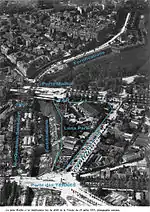Porte Maillot
The Porte Maillot (also known as the porte Mahiaulx, Mahiau or Mahiot after a Paille-maille court, or the Porte de Neuilly[1]) is one of the access points into Paris mentioned in 1860 and one of the ancient city gates in the Thiers wall.


Porte Maillot in 1919 and 2012
It was on the boundary between the 16th and the 17th arrondissements, at the junction of the avenue de la Grande-Armée, the boulevard de l’Amiral-Bruix and the boulevard Gouvion-Saint-Cyr. It gives its name to the Neuilly – Porte Maillot railway station and Porte Maillot metro station.
As at January 2023, the area was being redeveloped, expanding the underground RER station and greening the surface.[2]
References
- Alfred Fierro, Histoire et dictionnaire de Paris, Robert Laffont, 1580 pages, 1996 ISBN 2-221-07862-4 ; page 848 : "the porte de Neuilly is also called the porte Maillot"
- Gréco, Bertrand (15 January 2022). "À Paris, sur le chantier de la Porte Maillot « on voit [enfin] le bout du tunnel », assure le maire du 17e". Le Journal du Dimanche. Retrieved 15 January 2023.
This article is issued from Wikipedia. The text is licensed under Creative Commons - Attribution - Sharealike. Additional terms may apply for the media files.